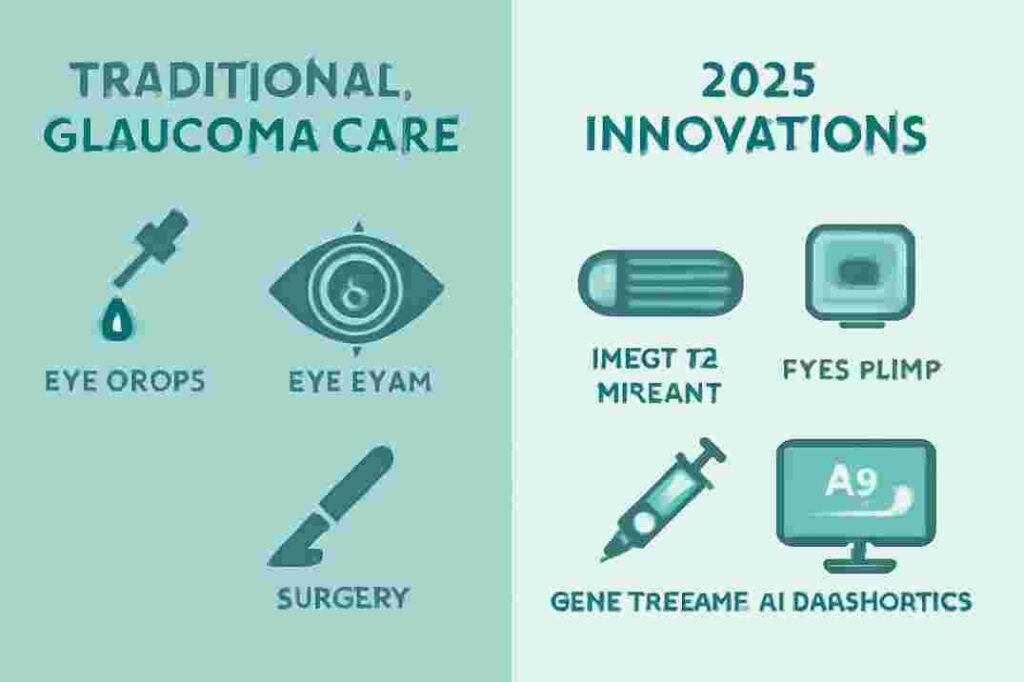Glaucoma Care: What You Need to Know
Bottom Line Up Front: Glaucoma affects approximately 4.22 million Americans (as of 2022 data) and is the leading cause of preventable blindness worldwide. Early detection through comprehensive eye exams and proper ongoing care can preserve your vision for life. With breakthrough treatments emerging in 2024-2025, including sustained-release implants and neuroprotective therapies, the outlook for glaucoma patients has never been brighter.
Understanding Glaucoma: The Silent Thief of Sight
Glaucoma is a group of eye diseases that damage the optic nerve—the critical pathway that transmits visual information from your eye to your brain. Often called the “silent thief of sight,” glaucoma typically develops without noticeable symptoms until significant vision loss has already occurred. Learn more about what glaucoma is and how it affects your vision.
What makes glaucoma particularly challenging is that vision loss begins in your peripheral (side) vision, areas you rely on for daily activities like driving, walking safely, and maintaining independence. By the time central vision is affected, substantial damage has already taken place. Understanding all about glaucoma can help you recognize why early detection is so crucial.
How Glaucoma Develops
The primary mechanism behind most types of glaucoma involves increased pressure within the eye, known as intraocular pressure (IOP). Your eye constantly produces a clear fluid called aqueous humor, which normally drains through a mesh-like structure called the trabecular meshwork. When this drainage system becomes blocked or inefficient, fluid builds up, creating pressure that gradually damages the delicate fibers of the optic nerve.
However, it’s important to understand that not everyone with high eye pressure develops glaucoma, and some people develop glaucoma even with normal eye pressure. This complexity underscores why regular comprehensive eye exams are essential, especially as you age.
Types of Glaucoma: Which One Affects You?
Primary Open-Angle Glaucoma
This is the most common form, affecting approximately 90% of glaucoma patients. The drainage angle where aqueous humor exits the eye remains open, but the drainage system gradually becomes less efficient over time. This type typically:
- Develops slowly and painlessly
- Shows no early warning signs
- Initially affects peripheral vision
- It can occur at any eye pressure level
Angle-Closure Glaucoma
Less common but potentially more serious, this type occurs when the drainage angle becomes blocked. It can be:
Acute angle-closure: A medical emergency requiring immediate treatment, with symptoms including:
- Severe eye pain
- Sudden vision loss
- Nausea and vomiting
- Halos around lights
- Red, swollen eyes
Chronic angle-closure: Develops gradually with subtle symptoms similar to open-angle glaucoma.
Normal-Tension Glaucoma
A form of open-angle glaucoma where optic nerve damage occurs despite normal eye pressure, emphasizing that glaucoma is more complex than simply elevated pressure.
Secondary Glaucoma
Results from other eye conditions, injuries, or medications, including:
- Trauma-related glaucoma
- Steroid-induced glaucoma
- Pigmentary glaucoma
- Pseudoexfoliative glaucoma
Risk Factors: Are You at Higher Risk?
Understanding your risk factors helps determine how frequently you need screening and what preventive measures might be beneficial.
Age-Related Risk
- Age 40+: Risk begins to increase
- Age 60+: Significantly higher risk
- Age 80+: Affects 1 in 10 people
Family History and Genetics
Recent 2024 research has identified 127 gene locations associated with glaucoma risk, including 44 newly discovered loci. If you have a family history of glaucoma, your risk increases 4-9 times compared to the general population.
Ethnicity Considerations
- African Americans: 6-8 times higher risk, often developing glaucoma at younger ages
- Hispanic/Latino populations: Increased risk, especially after age 60
- Asian populations: Higher risk for angle-closure glaucoma
Medical Conditions
- Diabetes: Increases risk by 35%. Learn about diabetic eye diseases and their connection to glaucoma.
- High blood pressure: Particularly when poorly controlled
- Heart disease: May affect blood flow to the optic nerve
- Severe nearsightedness: Associated with increased risk
- Previous eye injuries or surgeries
Lifestyle Factors
- Prolonged steroid use: Either topical or systemic
- Extreme physical positions: Activities that frequently place the head below the heart
- High caffeine consumption: May temporarily raise eye pressure
Early Warning Signs: When to Seek Care
The challenge with glaucoma is that most people experience no symptoms in the early stages. However, certain signs should prompt immediate evaluation:
Gradual Vision Changes
- Difficulty seeing objects in your peripheral vision
- Trouble navigating in low light
- Increased difficulty with tasks requiring good side vision, such as driving
Eye Discomfort (Less Common)
- Mild, persistent eye aching
- Halos around lights
- Frequent prescription changes
Emergency Symptoms (Acute Angle-Closure)
Seek immediate emergency care if you experience:
- Suddenly, severe eye pain
- Rapid vision loss
- Nausea and vomiting with eye pain
- Rainbow halos around lights
- Sudden eye redness
If you’re experiencing any of these symptoms, find out when you need an eye exam immediately—this could be a medical emergency.
Comprehensive Diagnosis: Advanced Testing for 2025
Modern glaucoma diagnosis goes far beyond checking eye pressure. Comprehensive eye and vision exams include multiple sophisticated tests to detect glaucoma in its earliest stages. Understanding what to expect during a routine eye exam can help you prepare for this crucial evaluation.
Intraocular Pressure Measurement (Tonometry)
While normal eye pressure ranges from 12-22 mmHg, what’s “normal” varies by individual. Some people can tolerate higher pressures without damage, while others develop glaucoma at lower pressures.
Optic Nerve Evaluation
Ophthalmoscopy: Direct examination of the optic nerve head to assess:
- Cup-to-disc ratio (normal is typically less than 0.3)
- Nerve fiber layer thickness
- Presence of hemorrhages
- Overall nerve health
Visual Field Testing
This critical test maps your peripheral vision, detecting early functional changes before you notice symptoms. Modern automated perimetry can detect vision loss when only 25-35% of nerve fibers are damaged.
Advanced Imaging Technologies
Optical Coherence Tomography (OCT): Provides detailed cross-sectional images of the retina and optic nerve, measuring nerve fiber thickness with micrometer precision. This technology can detect structural changes before functional vision loss occurs.
OCT Angiography: A newer technology that visualizes blood flow in the retina and optic nerve without injection, helping assess vascular factors in glaucoma.
Pupil Dilation
Examination of the drainage angle to determine glaucoma type and guide treatment decisions. Many patients wonder why they should get their eyes dilated—this process is essential for comprehensive glaucoma evaluation.
Pachymetry
Measurement of corneal thickness, which affects pressure readings and influences treatment decisions. Thinner corneas may indicate a higher risk.
Breakthrough Treatment Options: What’s New in 2025
The landscape of glaucoma treatment has evolved dramatically, offering patients more effective and convenient options than ever before.
Sustained-Release Drug Delivery Systems
iDose® TR Implant: FDA-approved in December 2023 and commercially launched in early 2024, this revolutionary implant delivers continuous travoprost therapy for extended periods. Clinical data show significant IOP reduction with 81% of patients free from topical IOP-lowering medications at 12 months.
Durysta® Implant: A biodegradable implant that releases bimatoprost over several months, providing consistent medication delivery and improved compliance.
Future Sustained-Release Options: Multiple companies are developing next-generation implants and drug delivery systems, including punctal plugs that release medication and under-eyelid devices.
Minimally Invasive Glaucoma Surgery (MIGS)
These procedures reduce eye pressure with minimal tissue disruption and faster recovery:
Trabectome: Uses heat to remove blocked drainage tissue. iStent: Tiny titanium device that creates a bypass in the drainage system.m Xen Gel Stent: Soft tube that creates a new drainage pathway OMNI Surgical System: 360-degree treatment of the drainage system
Revolutionary Laser Treatments
Direct Selective Laser Trabeculoplasty (DSLT): The FDA recently cleared the Belkin Eagle laser system, the first innovation in SLT technology in 20 years. This computer-guided system eliminates the need for contact lenses during treatment.
FLigHT (Femtosecond Laser Image-guided High-precision Trabeculotomy): An experimental precision laser treatment showing promising results in clinical trials.
Next-Generation Medications
Rho Kinase (ROCK) Inhibitors: Netarsudil (Rhopressa®) and combination drugs like netarsudil/latanoprost offer new mechanisms of action with dual benefits of pressure reduction and potential neuroprotection.
Nitric Oxide-Donating Drugs: Latanoprostene bunod (Vyzulta®) enhances traditional prostaglandin therapy with improved efficacy.
Preservative-Free Formulations: New preservative-free options reduce surface irritation and inflammation, particularly important for long-term use.
Innovative Non-Drug Approaches
FYSX Ocular Pressure Adjusting Pump: FDA-approved via De Novo classification in June 2024, this is the first non-surgical, non-drug treatment for glaucoma. The device uses negative pressure chambers worn during sleep to temporarily reduce eye pressure. Clinical trials show 100% of patients experienced pressure reduction, with 97% achieving more than 20% decrease (average 39% reduction from 20.2 mmHg to 12.2 mmHg). It’s indicated for patients with open-angle glaucoma and IOP ≤21 mmHg.
Emerging Neuroprotective Therapies
Gene Therapy: Researchers at Trinity College Dublin have developed promising gene therapy targeting matrix metalloproteinase-3 (MMP-3), showing significant neuroprotective effects in clinical trials.
Neuroprotective Compounds: Studies are investigating:
- Nicotinamide (Vitamin B3)
- Coenzyme Q10 and citicoline combinations
- Antioxidant therapies
- Neurotrophic factor delivery systems
Artificial Intelligence and Remote Monitoring
AI-Powered Diagnostics: Advanced algorithms can now detect glaucoma progression earlier and more accurately than traditional methods.
Remote Visual Field Testing: The Peripherex system allows patients to monitor their vision from home, providing valuable data between office visits.
Managing Glaucoma: Your Daily Care Routine
Successfully managing glaucoma requires consistent care and lifestyle adaptations that support your eye health and overall well-being.
Medication Management
Adherence is Critical: Missing even occasional doses can accelerate vision loss. Studies show that perfect adherence to glaucoma medications can slow progression by up to 40%.
Timing Strategies:
- Link drops to daily routines (meals, bedtime)
- Use smartphone reminders and alarms
- Consider pill organizers adapted for eye drops
- Ask family members for support and reminders
Proper Drop Technique:
- Wash hands thoroughly
- Tilt your head back or lie down
- Pull the lower eyelid down to create a pocket
- Apply one drop (more won’t help and may cause side effects)
- Close your eyes gently for 1-2 minutes
- Apply gentle pressure to the inner corner of the eye
- Wait 5 minutes between different medications
Lifestyle Modifications for Eye Health
Exercise Recommendations:
- Regular moderate exercise can reduce eye pressure by 20-30%
- Walking, swimming, and cycling are excellent choices
- Avoid: Inverted yoga positions, heavy weightlifting, high-intensity exercises that dramatically increase blood pressure
Dietary Considerations: While no specific diet prevents glaucoma, these nutrients support eye health:
- Antioxidants: Leafy greens, berries, nuts
- Omega-3 fatty acids: Fish, flax seeds, walnuts
- Nitrates: Beets, dark leafy greens (may support eye pressure reduction)
Discover more about nutrition for eye health and learn about the best foods for eye health to support your overall vision wellness.
Hydration and Caffeine:
- Stay well-hydrated throughout the day
- Limit large amounts of fluid consumed quickly (can temporarily raise eye pressure)
- Moderate caffeine intake (excessive amounts may increase pressure)
Sleep and Stress Management
Quality Sleep:
- Use a slightly elevated head position while sleeping
- Address sleep apnea if present (linked to glaucoma progression)
- Maintain consistent sleep schedules
Stress Reduction: Research shows that chronic stress and anxiety can accelerate glaucoma progression. Learn more about stress and vision, and effective stress management strategies that include:
- Regular meditation or mindfulness practices
- Deep breathing exercises
- Counseling or therapy when needed
- Social support and community involvement
Environmental Considerations
Protective Eyewear:
- Safety glasses during yard work, sports, or home projects
- UV-protective sunglasses (UV exposure may contribute to some types of glaucoma)
Home Safety:
- Improve lighting throughout your home
- Use contrasting colors to mark edges and boundaries
- Remove tripping hazards
- Practice “scanning” techniques when walking
The Emotional Journey: Addressing Anxiety and Mental Health
A glaucoma diagnosis often triggers significant emotional responses, and research consistently shows that anxiety and depression are more common among glaucoma patients than in the general population.
Understanding the Psychological Impact
Common Emotional Responses:
- Fear of blindness and loss of independence
- Anxiety about disease progression
- Depression related to lifestyle limitations
- Frustration with complex medication routines
- Concern about financial burden
The Stress-Glaucoma Connection: Recent research reveals that anxiety and depression don’t just result from glaucoma—they may accelerate disease progression. Studies show that patients with higher anxiety levels experience faster retinal nerve fiber layer thinning.
Coping Strategies
Build Your Support Network:
- Connect with other glaucoma patients through support groups
- Maintain open communication with family and friends
- Consider counseling or therapy to develop coping skills
- Work with low-vision specialists when needed
Focus on What You Can Control:
- Consistent medication use
- Regular follow-up appointments
- Healthy lifestyle choices
- Stress management techniques
- Staying informed about new treatments
Practical Adaptations:
- Use large-print materials and improved lighting
- Explore assistive technologies for reading and navigation
- Modify daily activities to accommodate vision changes
- Maintain social activities and hobbies with adaptations as needed
Regular Monitoring: What to Expect During Follow-Up Care
Glaucoma management requires lifelong monitoring, with visit frequency depending on disease severity and stability.
Typical Follow-Up Schedule
Newly Diagnosed or Unstable Glaucoma:
- Every 3-4 months initially
- More frequent pressure checks during medication adjustments
Stable Glaucoma:
- Every 4-6 months for most patients
- Annual comprehensive examinations with full testing
Advanced or Rapidly Progressing Glaucoma:
- Every 2-3 months or more frequently as needed
What Happens During Visits
Routine Monitoring:
- Intraocular pressure measurement
- Optic nerve examination
- Visual field testing (annually or as indicated)
- OCT imaging to track structural changes
- Medication review and adherence assessment
Advanced Testing When Indicated:
- Gonioscopy to reassess drainage angles
- Additional imaging studies
- Corneal thickness measurement
- Blood pressure and other systemic health assessments
When to Contact Your Eye Care Provider
Urgent Situations:
- Sudden vision changes
- Severe eye pain
- Signs of acute angle-closure
- Significant medication side effects
Routine Updates:
- Difficulty with medication adherence
- New symptoms or concerns
- Changes in other health conditions
- Questions about daily activities or adaptations
Prevention and Early Detection: Protecting Your Vision
While glaucoma cannot always be prevented, early detection and proper management can preserve vision for a lifetime. Implementing 5 things you can do to protect your eye health and following lifestyle practices for eye health can significantly reduce your risk.
Screening Recommendations
General Population:
- Ages 40-54: Every 1-3 years
- Ages 55-64: Every 1-2 years
- Ages 65+: Every 6-12 months
High-Risk Individuals:
- Ages 35+: Every 1-2 years
- Family history: Earlier and more frequent screening
- Other risk factors: Customized schedule based on individual risk
Choosing the Right Eye Care Provider
What to Look For:
- Board-certified ophthalmologist or optometrist
- Experience with glaucoma diagnosis and management
- Access to advanced diagnostic equipment
- Collaborative approach to care
- Clear communication about your condition and treatment options
Learn how to find a great eye doctor and explore our comprehensive eye care services designed to meet your individual needs.
Questions to Ask:
- What type of glaucoma do I have?
- What is my target eye pressure?
- How will we monitor my condition?
- What are my treatment options?
- How can I best manage side effects?
- When should I contact you with concerns?
Latest Research and Future Directions
The field of glaucoma research is advancing rapidly, with multiple promising developments on the horizon.
Gene Therapy Advances
Recent breakthroughs include:
- AAV-NDI1 therapy: Showing significant benefit in both animal models and human cells
- BDNF and TrKB receptor enhancement: Providing sustained neuroprotection
- Matrix metalloproteinase targeting: Protecting and regenerating optic nerve cells
Regenerative Medicine
Vision Restoration Research:
- Stem cell therapies to replace damaged retinal ganglion cells
- Optic nerve regeneration techniques
- Neural pathway reconstruction methods
Artificial Intelligence Applications
Diagnostic Improvements:
- Earlier detection of progression
- Personalized treatment recommendations
- Automated monitoring systems
- Predictive modeling for individual patients
Cannabinoid Therapies
Clinical trials are investigating:
- SBI-100 ophthalmic emulsion: A synthetic THC prodrug showing 24% average IOP reduction
- Topical cannabinoid formulations for improved delivery
- Combination therapies with traditional medications
Living Well with Glaucoma: Success Stories and Hope
With proper care, the vast majority of glaucoma patients maintain functional vision throughout their lives. Many patients continue driving, working, and enjoying recreational activities for decades after diagnosis.
Key Success Factors
Excellent Outcomes Are Achieved When Patients:
- Maintain consistent medication use
- Attend regular follow-up appointments
- Adopt healthy lifestyle practices
- Stay informed about their condition
- Build strong relationships with their care team
- Address mental health needs proactively
Technological Assistance
Available Tools:
- Smartphone apps for medication reminders
- Low-vision aids and magnification devices
- Voice-activated home technology
- GPS navigation systems with audio guidance
- Large-print and high-contrast materials
Community Resources
Support Organizations:
- Glaucoma Research Foundation
- American Foundation for the Blind
- Local support groups and community centers
- Online forums and educational resources
- Vision rehabilitation services
Financial Considerations and Insurance Coverage
Understanding the costs and coverage options for glaucoma care helps ensure you receive necessary treatment without financial hardship. Glaucoma costs the U.S. economy approximately $2.86 billion annually in direct costs and productivity losses.
Insurance Coverage
Most Insurance Plans Cover:
- Routine glaucoma screening and monitoring
- Standard glaucoma medications
- Traditional surgical procedures
- Basic diagnostic testing
May Require Prior Authorization:
- Newer sustained-release implants
- Minimally invasive glaucoma surgeries
- Advanced diagnostic imaging
- Brand-name medications when generics are available
Cost-Saving Strategies
Medication Costs:
- Generic alternatives when appropriate
- Pharmaceutical company patient assistance programs
- Prescription discount programs
- Mail-order pharmacy options for maintenance medications
Treatment Planning:
- Discuss cost considerations with your provider
- Explore clinical trial opportunities
- Consider combination therapies that may be more cost-effective
- Plan for long-term care expenses
Key Resources and Citations
This comprehensive guide is based on the latest research and clinical data. For readers seeking additional information, the following resources provided critical insights for this article:
1. Latest Prevalence Data – JAMA Ophthalmology Study (2024)
“Prevalence of Glaucoma Among US Adults in 2022”
Source: Institute for Health Metrics and Evaluation & CDC Vision Health Initiative
https://www.healthdata.org/research-analysis/library/prevalence-glaucoma-among-us-adults-2022
This landmark study provides the most current glaucoma prevalence estimates, finding that 4.22 million Americans have glaucoma—higher than previously estimated. The research includes state and county-level data and demographic breakdowns essential for understanding the current scope of the disease.
2. Breakthrough Treatment Research – Glaucoma Research Foundation
“Exploring The Latest Breakthroughs In Glaucoma Research”
Source: Glaucoma Research Foundation, September 2024
https://glaucoma.org/articles/exploring-the-latest-breakthroughs-in-glaucoma-research
This comprehensive review covers the latest treatment advances, including the iDose TR implant, gene therapy developments, new medications like Omlonti, and vision restoration research. Essential reading for understanding cutting-edge glaucoma therapies entering clinical practice.
3. Patient Mental Health Research – Scientific Reports
“The Effect of Anxiety and Depression on Progression of Glaucoma”
Source: Nature Scientific Reports, January 2021
https://www.nature.com/articles/s41598-021-81512-0
This crucial research demonstrates the bidirectional relationship between mental health and glaucoma progression, showing that patients with higher anxiety levels experience faster retinal nerve fiber layer thinning. This study informed our comprehensive approach to addressing both medical and emotional aspects of glaucoma care.
Additional Professional Resources:
- American Academy of Ophthalmology Glaucoma Resources: aao.org/eye-health/diseases/what-is-glaucoma
- National Eye Institute Glaucoma Information: nei.nih.gov/learn-about-eye-health/eye-conditions-and-diseases/glaucoma
- Glaucoma Research Foundation Patient Resources: glaucoma.org/understanding-glaucoma
Conclusion: Your Vision, Your Future
Glaucoma may be called the “silent thief of sight,” but with today’s advanced diagnostic tools and breakthrough treatments, it doesn’t have to steal your vision or your quality of life. The key is early detection, consistent treatment, and proactive management of both the medical and emotional aspects of the condition.
Remember These Essential Points:
- Early detection saves sight: Regular comprehensive eye exams can catch glaucoma before significant vision loss occurs
- Treatment works: With proper management, most patients maintain functional vision throughout their lives
- Consistency is crucial: Adhering to medication schedules and follow-up appointments dramatically improves outcomes
- New hope on the horizon: 2025 brings exciting advances in sustained-release treatments, neuroprotection, and regenerative therapies
- You’re not alone: Support is available through healthcare providers, family, friends, and the broader glaucoma community.
If you’re at risk for glaucoma or haven’t had a comprehensive eye exam recently, don’t wait. Early action is your best defense against vision loss. If you’ve been diagnosed with glaucoma, take heart in knowing that with today’s treatments and your commitment to care, you can look forward to a future with preserved vision and continued independence.
The future of glaucoma care has never been brighter, and your vision is worth protecting. Take the first step today by scheduling your comprehensive eye examination and taking control of your eye health journey.
At Cannon EyeCare, we specialize in glaucoma evaluation and management, providing personalized care that combines the latest treatments with our commitment to thorough excellence and Midwestern hospitality. Our family eye care approach ensures that every member of your family receives the comprehensive attention they deserve.
FAQs
-
Glaucoma damages the optic nerve; high or fluctuating eye pressure raises risk, but some people have glaucoma with normal pressure and others don’t despite high pressure. Regular testing is essential.




